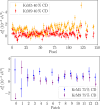Measurement of the inhomogeneity of the KATRIN tritium source electric potential by high-resolution spectroscopy of conversion electrons from Kr
- PMID: 40656865
- PMCID: PMC12241207
- DOI: 10.1140/epjc/s10052-025-14354-z
Measurement of the inhomogeneity of the KATRIN tritium source electric potential by high-resolution spectroscopy of conversion electrons from Kr
Abstract
Precision spectroscopy of the electron spectrum of the tritium -decay near the kinematic endpoint is a direct method to determine the effective electron antineutrino mass. The KArlsruhe TRItium Neutrino (KATRIN) experiment aims to determine this quantity with a sensitivity of better than ( C.L.). An inhomogeneous electric potential in the tritium source of KATRIN can lead to distortions of the -spectrum, which directly impact the neutrino-mass observable. This effect can be quantified through precision spectroscopy of the conversion-electrons of co-circulated metastable . Therefore, dedicated, several-weeks long measurement campaigns have been performed within the KATRIN data taking schedule. In this work, we infer the tritium source potential observables from these measurements, and present their implications for the neutrino-mass determination.
© The Author(s) 2025.
Figures







References
-
- Y. Fukuda et al., Phys. Rev. Lett. 81, 1562–1567 (1998). 10.1103/PhysRevLett.81.1562
-
- Q.R. Ahmad et al., Phys. Rev. Lett. 89, 011301 (2002). 10.1103/PhysRevLett.89.011301 - PubMed
-
- J.A. Formaggio, A.L.C. de Gouva, R.G.H. Robertson, Phys. Rep. 914, 1–54 (2021). 10.1016/j.physrep.2021.02.002
-
- R.G.H. Robertson et al., Phys. Rev. Lett. 67, 957–960 (1991). 10.1103/PhysRevLett.67.957 - PubMed
-
- W. Stoeffl, D.J. Decman, Phys. Rev. Lett. 75, 3237–3240 (1995). 10.1103/PhysRevLett.75.3237 - PubMed
LinkOut - more resources
Full Text Sources
